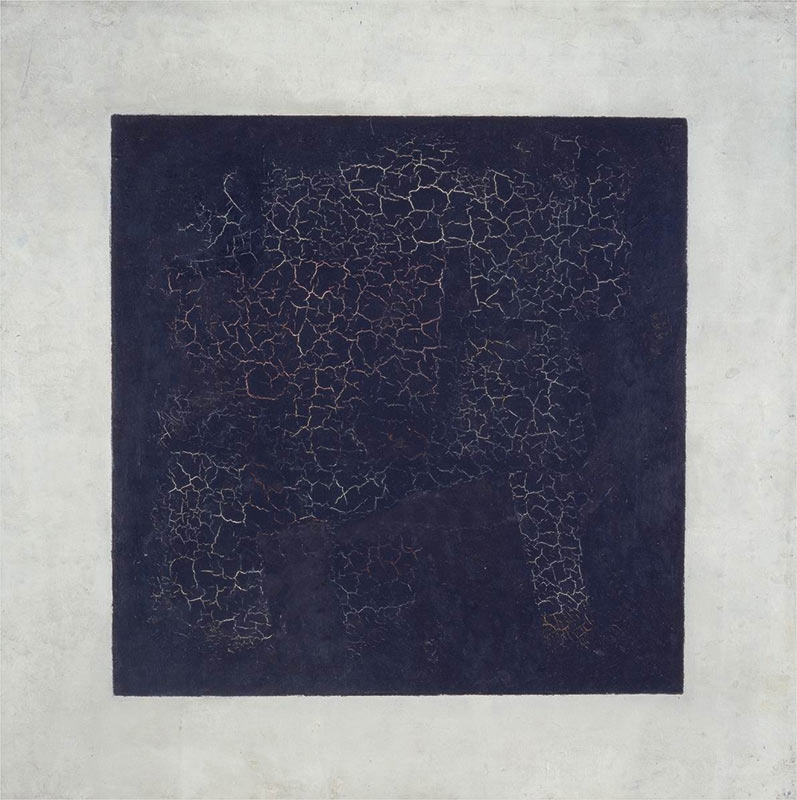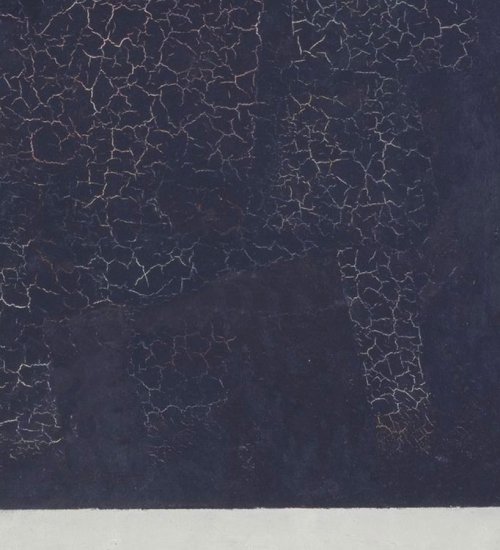
Accueil > Les rubriques > Images > The futures of the monochrome
The futures of the monochrome
,
The following text is based on the final chapter of my recently published book ‘The Simple Truth. The Monochrome in Modern Art’ (Reaktion Books, 2020)
The pristine simplicity of the original conception of Malevich’s Black Square of 1915 [FIG 1] has been cruelly betrayed by the attrition of time. Malevich painted it over two earlier works, one of which is clearly visible as the surface layer of black and white paint has cracked and fissured to reveal the ghost of a Suprematist composition. The other, painted in his Cubo-Futurist style of a few years earlier, has only recently been revealed through X-ray analysis [FIG. 2]. But the problems with the painting’s condition began almost immediately, which is one reason why Malevich painted another version of Black Square between 1923 and 1924. He then painted a third in 1929, and a fourth in the late 1920s or early 1930s – which was the one carried at his funeral in Leningrad in 1935. Malevich’s willingness to repeat the same simple motif underscores the suggestion made earlier that Black Square, like many subsequent monochromes, was always intended more as an idea than as a unique plastic reality. In this sense, the deterioration of one physical example does nothing to diminish the potency of the idea that was meant to imbue the object with meaning.

- FIG 2 : Detail, Kazimir Malevich, Black Square
- 1915, oil on canvas, 79.5 x 79.5 cm (State Tretyakov Gallery, Moscow)
But yet more layers of meaning have recently been uncovered below the surface of Black Square. In 2015 the same analysis of the painting that revealed the second buried painting showed that partly legible words, which previously were thought to be the artist’s signature, actually say in Russian : ‘A battle of negroes . . . [continuation illegible].’ No doubt Malevich was intending toallude to the visual puns employed in the late nineteenth century by Alphonse Allais and others to deflate the pretensions of Symbolist art. [1]
This revelation adds another potential meaning to Black Square, one that, however briefly and for whatever reason, was part of Malevich’s consciously intended meaning. The recently discovered text has now become another component in the wider story of Malevich’s pioneering work, which also includes its unintended material disintegration. All these potential contexts, and surely many others, are intrinsic to any response to the work itself today. In assessing Malevich’s painting today, we cannot ignore the evidence of our eyes, and the additional information supplied by the X-ray analysis, thinking of it as primarily a concept in the mind, without severely limiting our experience of it. The deterioration of the painting is part of what it now means, as is the scribbled text. The chance effects caused by the instability of the materials used by Malevich have contributed additional levels of affect and association which are part of the work’s reception, and these suggest a vulnerability, decay and abjectness that were far from the artist’s mind when he made it, while the words open the painting up to a decidedly ‘impure’ context.
But above all, the sorry material state of Black Square reminds us that the monochrome is more than a hundred years old. An art hell-bent on erasing the traces of history now definitely has its own, and the values that underpinned it have brought us to the edge of extinction. Thus, any attempt to understand the monochrome from the perspective of the present day will require the inclusion of this history and the various interpretative frameworks that belong to it. The ‘contemporary’ monochrome needs to be seen as both a summation of that history, and as part of an ongoing process in which new meanings continuously emerge to challenge previous dogmas.

- FIG 3 : Chung Sang-Hwa, Untitled 86-1-7
- 1986, Acrylic and kaolin on canvas, 227,3 x 181,8 cm (Gallery Hyundai)
The existence of non-Western monochromy, such as Korean Dansaekhwa, for example, is especially significant in this context as it reveals that there are other possibilities for the monochrome. Currently on show at the Museum of Modern and Contemporary Art in Seoul is a retrospective of one of the most important of these Korean artists, Chung Sang-Hwa (22 May - 26 September) [FIG 3 and 4] Through the way he works his surfaces by folding and cracking the kaolin he mixes with acrylic paint, Chung uses the concept of the monochrome to explore haptics more than optics. Unlike the other perceptual systems - vision, hearing, tasting and smelling - which employ separate organs like the eyes, ears, mouth and nose in order to deliver perceptions, the haptic system involves the body holistically, engaging two corporeal functions : the tactile and the kinesthetic. The former brings direct physical contact, providing information about location, surface, vibration and temperature. To touch is to gain clarification. Through caressing, grasping, pushing, pressing, rubbing, kneading, cutting or weighing the hand functions as an executive organ, both perceiving and taking action. The kinesthetic involves movement, and knowledge about position, orientation and force. We discover the qualities of objects, and how to act in relation to them. The accumulation of knowledge gained through haptics is slower than vision, but more difficult to deceive. While it is ‘dark’ or ‘blind’ according to the criteria established by vision, the haptic provides supplementary knowledge revealed intimately through close contact with the world, and confirms and demystifies. As a result of emphasizing the haptic in painting, Chung shifts attention shifts in two directions. We become more aware of the relationship between a painting’s surface and what lies outside it in the ambient space, which now ‘invades’ the frame of the painting. The impact on the painting of this ambient space is not static, but changes depending on viewing position, therefore making kinesthetic movements part of the work, and rendering it indeterminate and procedural, that is, involved in a process within which we participate. Furthermore, we are moved away from the usual retinal or optical response to painting - away from the activity of looking and thinking, toward the far less clearly consciously mappable region of touch and animation, the ‘darkness’ of the haptic sense.

- FIG 4 : Chung Sang-Hwa Untitled 2017-2-5
- 2017 Acrylic and kaolin on canvas 130 x 97 cm (Bergggreun Gallery)
Chung’s work draws attention to the fact that one important and still incomplete legacy of the monochrome is how it can serve to foreground a deep and ongoing cultural problem that is determined by the specific Western worldview. This problem concerns the relationship between making and thinking, crafting and knowing, and how we understand the way raw materials are transformed into stable, ordered and meaningful forms through mental activity combined with bodily action. In this context, tracing the evolution of the monochrome through modern art has revealed how it serves an important role in consolidating a specific cultural idea : that a work of art is preconceived form imposed on a minimal, inert and in itself meaningless material artefact. It is interpreted as simply an outcome that is the consequence of a sequence of antecedent conditions traceable to an idea in the mind of the artist. A fundamental distinction is made between conceiving and making, and between a concept and the material outcome. [2] As a result, the intellectual aspect of art is elevated to the highest position, and the mental is sundered from the material and physical. The mind is raised over the body.
This bias is evident in many aspects of modern and contemporary art, where knowledge associated with intellectual analysis is emphasized over the implicit and personal. But while the monochrome often seems inextricably bound to this ‘calculus’, we have seen how it can also be understood to challenge such assumptions. With special clarity a monochrome can draw attention to the fact that when we seek to make sense of a work of art we are using a combination of the formal and conceptual as well as the preconceptual, non-formal and felt, and that the categories of thought we employ have experiential and perceptual origins, and the way in which our embodied mind experiences art informs the concepts we articulate. The making of meaning is essentially a creative act, and is inextricably bound to sensorimotor, felt, performative and personal levels of experience. In this sense, the monochrome serves to draw attention with special clarity to how perception combines observation with memory, reflection and imagination.
In the 1960s the psychologist and art theorist Rudolf Arnheim wrote that where art is concerned, ‘simplicity is not enough’ :
If simplicity were the overriding goal of art, evenly stained canvases or perfect cubes would be the most desirable art objects. In recent years, artists have in fact provided us with such examples of ‘minimal art.’ Historically, they were needed to soothe the eyes of a generation that had gotten lost in complexity and disorder, but they also served to prove that once it has fulfilled its therapeutic function, so bland a diet does not satisfy. [3]
Arnheim is surely correct. In most cases, ‘so bland a diet’ is definitely not enough to sustain critical interest, and as an artistic goal is rarely enough to sustain a whole career. But I think Arnheim is too sweeping in his judgement. When considered within a holistic context, as part of a network, and within the contemporary cultural situation, simplicity in art certainly does have its place. Perhaps today more than ever we shouldn’t be quite so quick to dismiss the importance of the broadly ‘therapeutic’ potential of an art dedicated to visual simplicity. After all, we are certainly no less ‘lost in complexity and disorder’ than we were in the 1960s, and many of the ideological agendas that once sustained modern art have lost credibility. In fact, the potential of a work of art to serve a therapeutic function, where ‘therapeutic’ is defined as ‘relating to the treatment of disease or disorders by remedial agents or methods’ – seems especially valuable today in what has been called our ‘burnout society’. [4]
Humans are voracious gatherers of both physical and mental sustenance, and if information were food, we would see that today we are all massively overweight. The new electronic systems have reached unprecedented levels of pervasiveness and targeted specificity, and are cleverly designed to capture our attention and to direct us towards specific, often trivial and commercialized goals. Far from producing greater freedom, the new digital communication technologies seem to be enslaving us. Mega-data and the multitasking capacities offered by digital technology exponentially increase our levels of physical, psychological and moral fatigue. In such a world, one in which high levels of attentional interference, distraction and manipulation are increasingly the norm, the future of personal and societal well-being is far from certain. We may have acquired enormously enhanced technological powers, but this doesn’t seem to have brought greater peace of mind. Attention has become a lucrative commodity, and we seem to have voluntarily surrendered this, our most precious resource, permitting our minds to be infiltrated by the ‘attention merchants.’ [5] This massive expansion in the control of attention is especially worrying, because we have no choice but to pay attention to something. In this situation, one characterized by an inflated and devalued economy of attention, the arts can function as specific ‘attention capture devices’ that exist alongside those derived from natural stimuli, human social interactions and the technical devices that, in one way or another, seek to attract our attention. [6] But rather than trying to counteract this spectacular sensory and cognitive overload, the attentional spaces demarcated by contemporary art often seem to be actively aiming to emulate and compete with it. Or, alternatively, our galleries of contemporary art display predominantly non-aesthetic and discursive content that directs the mind towards intellectual concepts, that is, towards articulated knowledge that often engages with explicitly socio-political issues.
There is, however, another kind of attentional space that art can nurture. [7] Within contemporary society the unknowable or ineffable has largely been removed from the centre of human life, and there is an enormous lack of viable space and time within which to perform contemplative rituals, a fact to which the current boom in the ‘wellness’ industry attests. In this context, the arts can be understood as extending an invitation to spend attention profitably in ways that are predominantly contemplative rather thanactive. The Oxford English Dictionary defines ‘contemplation’ first as ‘the action of beholding, or looking at with attention and thought’, and second as ‘the action of contemplating or mentally viewing ; the action of thinking about a thing continuously ; attentive consideration, study’. Contemplation counters the scattering of attention that is the dominant feature of our culture through providing space and time for the imagination to be grounded in inner integrity. In this sense, the monochrome’s apparent simplicity can be experienced as an especially effective means of accessing a contemplative space that resists the dissipating forces which increasingly surround us and invade our consciousness.
Notes
[1] Kelly Grovier, in a BBC news article on the discovery, makes a rather swinging claim that Malevich’s words, ‘too gutless to show their face in full view, are thought to be an allusion to a racist phrase – used by a French humourist for an 1897 cartoon of a black square. With that disappointing discovery, which succeeded in recontextualizing the work from pioneering masterpiece to appalling misadventure, the inner light of a painting that had, for decades, been the source of meaningful meditation, suddenly went out.’ Kelly Grovier, ‘The Racist Message Hidden in a Masterpiece’, www.bbc.com, 12 March 2018. Though seemingly obvious to us, the joke was not consciously racist for Malevich, who could be no more than a man of his times – that is, someone largely limited by the prejudices of his culture – and primarily had in mind an allusion to Allais and his circle, not an overtly racist joke.
[2] I am drawing here on Tim Ingold, Making : Anthropology, Archaeology, Art and Architecture (London and New York, 2013).
[3] Rudolf Arnheim, Visual Language (Berkeley and Los Angeles, CA., 1969), p. 410.
[4] Byung-Chul Han, The Burnout Society, trans. Erik Butler (Stanford, CA., 2015). Han’s bestselling book, first published in 2010 in German, pre-dates the arrival of the smartphone, which has certainly enormously amplified the symptoms he diagnosed. The definition of ‘therapeutic’ is from the Merriam-Webster online dictionary.
[5] Tim Wu, The Attention Merchants : The Epic Scramble to Get Inside Our Heads (New York, 2016).
[6] ‘Attention capture device’ is a phrase used by Wu, ibid.
[7] For an especially insightful discussion of this see Sven Birkerts in Changing the Subject : Art and Attention in the Internet Age (Minneapolis, MN, 2015).
Figure 1 : Kazimir Malevich, (Black Square), 1915, oil on canvas, 79.5 x 79.5 cm (State Tretyakov Gallery, Moscow)
